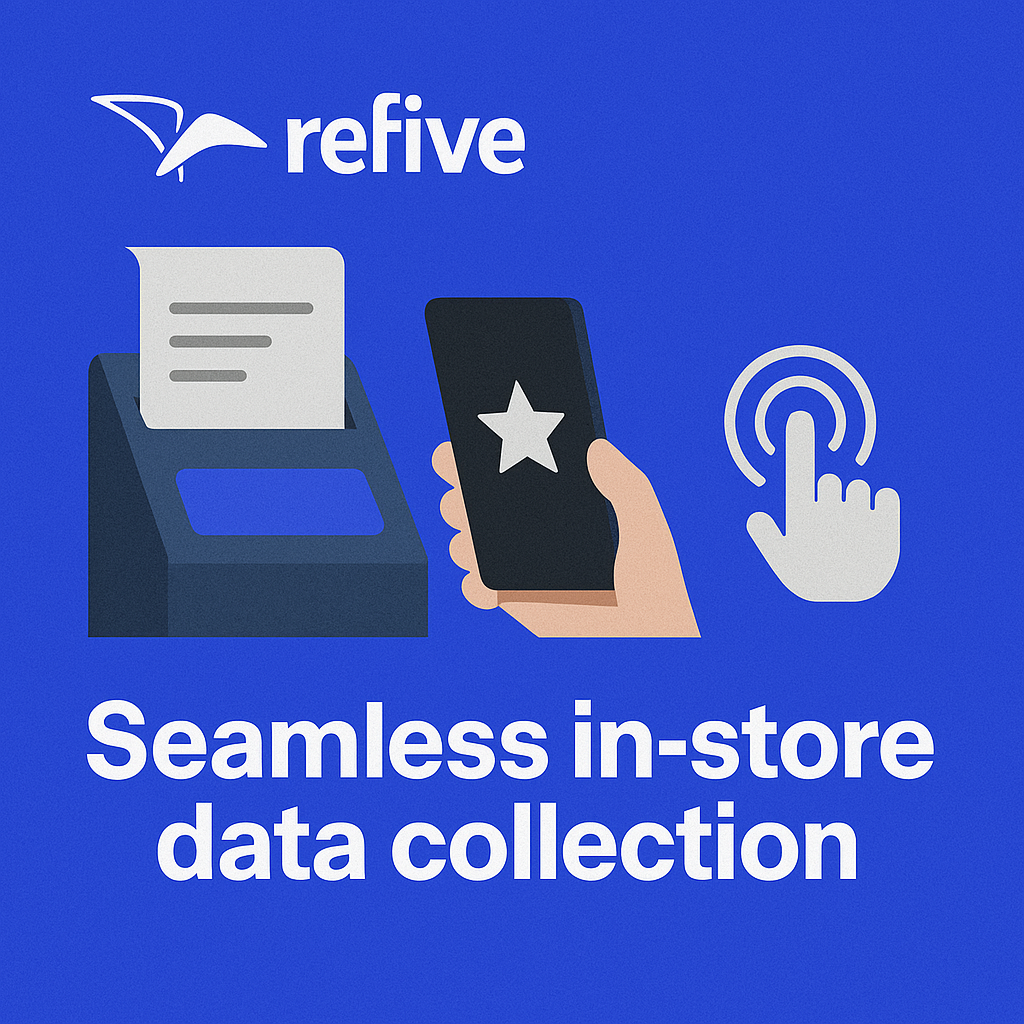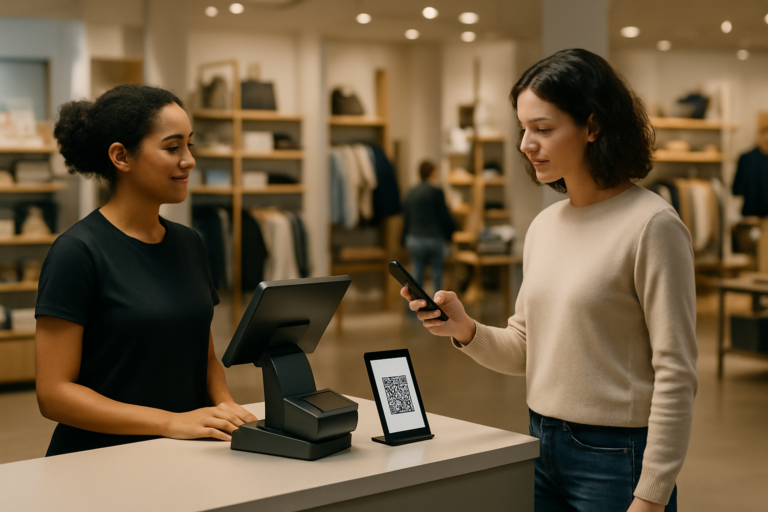In today’s competitive retail landscape, personalised customer engagement is no longer a luxury—it’s a necessity. While e-commerce companies have long mastered the art of data collection and personalisation, brick-and-mortar retailers have struggled to achieve the same level of customer understanding. Digital receipts and smart touchpoints offer a promising solution, bridging the gap between online and in-store experiences.
As retailers contemplate implementing these technologies, many face a critical decision: build an in-house solution or partner with a specialised vendor like refive? We have witnessed numerous retailers navigate this decision, and we’ve observed that the “build vs buy” question is far more complex than it initially appears.
The Allure of Building In-House
The appeal of developing an in-house digital receipt solution is understandable. Your IT team knows your systems best, and building internally promises complete control over the solution. There’s also the perception that a custom-built system will perfectly align with your unique business needs.
However, this approach comes with significant challenges that are often underestimated.
Operational Challenges of Building In-House
Integration Complexity
Digital receipts may seem straightforward, but they require the flexibility of seamless integration with multiple systems: point-of-sale (POS), customer relationship management (CRM), loyalty programs, marketing automation tools, and more. Comparatively, an in-house solution may typically solve simpler issues like sending the digital receipt on email via a QR code that is being generated.
Each of the integrations mentioned presents unique challenges:
- Legacy POS systems often use proprietary protocols that require specialised knowledge
- GDPR and other privacy regulations mandate specific consent management processes
- Data must flow bidirectionally between systems in near real-time
- Changes to any integrated system can break the entire solution
Specialised vendors like refive have already solved these integration puzzles across dozens of different retail environments. Their solutions come with pre-built connectors for most common retail systems, dramatically reducing implementation time and maintenance headaches.
Staff Resources and In-Store Experience
Developing a robust digital receipt platform requires diverse expertise:
- Backend developers familiar with retail systems
- Frontend developers for customer-facing applications
- UX/UI designers for receipt templates and customer interfaces
- Data engineers to manage the flow of transaction data
- Security specialists to protect sensitive customer information
- Compliance experts to ensure adherence to privacy regulations
Most retail IT departments are already stretched thin managing existing systems. Adding a complex new project means either hiring additional staff—a significant expense—or pulling resources from other critical initiatives.
The Checkout Experience Problem
A common pitfall of in-house solutions is underestimating the impact on the checkout experience. We’ve seen multiple global retailers attempt to build their own data collection systems that:
- Created significant friction during checkout, adding 15-30 seconds per transaction
- Placed additional operational burden on already busy store associates
- Required customers to manually enter data at the POS terminal
- Interrupted the natural flow of the customer experience at a critical moment
- Resulted in poor data quality due to time pressure and customer reluctance
One international sportswear retailer implemented an in-house solution that directly captured email addresses at POS. Despite substantial investment, they found that:
- Customers were reluctant to provide information during the payment process
- Staff felt uncomfortable repeatedly asking for personal data
- The checkout process was disrupted, creating queues during peak periods
- Data quality suffered with hurried customers providing incorrect information
- The solution couldn’t adapt to different market needs across their global footprint
After recognizing these issues, they began seeking alternative approaches that would provide a more premium customer experience while still capturing valuable data.
Marketing Challenges
Feature Evolution
The digital receipt landscape is evolving rapidly. Retailers are seeing that there is much more value in receipts than just providing a simple receipt PDF. What began as simple email receipts has expanded to include:
- Interactive receipt content with personalised recommendations
- Integration with mobile wallets and the data capturing opportunity to connect via WhatsApp, Email, WalletPasses
- QR code-based touchpoints throughout the store journey
- Omnichannel purchase history and valuable insights; creation of rich customer profiles across visits that include – interactional data, purchase history, feedback and more
- Loyalty program synchronisation and acquisition channel for Apps & Loyalty
- Return management capabilities
- Touchpoints can be used for – personalised recommendations and targeted offers for cross-sell & upsell
- Marketing tracking and retargeting
Keeping pace with these innovations while maintaining day-to-day operations is challenging even for dedicated providers. For in-house teams with divided attention, it’s nearly impossible.
Data Actionability
Collecting data is only the beginning. The real value comes from analysing and activating that data to drive customer behaviour. This requires:
- Sophisticated segmentation capabilities
- A/B testing infrastructure
- Campaign management tools
- Reporting dashboards
- Predictive analytics

Specialists like refive have invested years in developing these capabilities, refining them across diverse retail environments. Their platforms offer out-of-the-box functionality that would take internal teams months or years to develop.
Cost Considerations
Development Costs
The initial investment to build a digital receipt platform typically is a significant amount for a mid-sized retailer, including:
- Software development (6-12 months minimum)
- Integration work
- Security audits
- Testing across multiple environments
- Staff training
- Documentation
These costs are incurred before a single digital receipt is sent to customers.
Ongoing Maintenance
Once deployed, the system requires continuous attention:
- Security patches and updates
- Compatibility testing with POS updates
- Regulatory compliance monitoring
- Performance optimisation
- Bug fixes and customer support
- Feature enhancements to meet evolving expectations
These ongoing costs typically amount to 15-25% of the initial development investment annually—a significant line item that often goes unbudgeted in initial projections.
Opportunity Cost
Perhaps the most overlooked expense is opportunity cost. Every hour your team spends building and maintaining a digital receipt system is an hour not spent on core business initiatives that directly drive revenue.
The Vendor Advantage
Specialised vendors like refive offer compelling advantages:
Rapid Deployment
While in-house solutions typically take 6-12 months to implement, vendor platforms can often be deployed in 6-12 weeks. This means you can begin collecting customer data and seeing ROI much sooner.
Premium Customer Experience
Leading vendors offer multiple implementation options tailored to different store environments:
- Static QR code solutions that feel premium and non-intrusive
- Secondary screen approaches where appropriate
- Mobile POS integrations for flexible checkout
- Adaptable solutions for varied connectivity environments
These options ensure the data collection process enhances rather than detracts from the customer experience, maintaining the premium feel that leading brands require.
Global Implementation Flexibility
For international retailers, specialised vendors offer critical flexibility:
- Country-specific implementation models that respect local regulations
- Adaptations for varied technical infrastructures across markets
- Multilingual customer interfaces and support
- Consistent data collection despite inconsistent store environments
- Unified reporting across diverse implementation methods
This flexibility allows global brands to maintain consistent customer experiences and data standards while accommodating regional variations.
Proven Reliability
Vendors have battle-tested their systems across numerous retail environments. They’ve already encountered and solved the edge cases that would inevitably arise in a new implementation.
Continuous Innovation
The competitive vendor landscape drives continuous innovation. Because digital receipts and customer data capture are their core business, vendors invest heavily in research and development. Your business benefits from this innovation without additional investment.
Economies of Scale
Vendors spread development and maintenance costs across multiple clients, making sophisticated capabilities affordable even for medium-sized retailers.
Risk Mitigation
Vendors assume much of the risk associated with system performance, security, and compliance. Their business depends on getting these elements right across all clients.
Finding the Right Balance
The best approach often combines vendor expertise with internal knowledge:
- Core Platform: Partner with a specialised vendor like refive for the core digital receipt and data capture platform
- Integration: Work together on integration with your specific systems
- Customisation: Leverage the vendor’s flexibility to customise customer-facing elements
- Data Activation: Use your internal marketing knowledge to activate the data through the vendor’s tools
Conclusion
While building in-house offers the illusion of control, partnering with a specialised vendor typically delivers faster implementation, lower total cost of ownership, reduced risk, and superior capabilities. As retail continues to evolve, the ability to quickly adapt to changing customer expectations becomes increasingly valuable.
The retailers who succeed in the coming years will be those who focus their resources on their core business while leveraging specialist partners for complex technical solutions like digital receipts and in-store data capture. In the build vs buy decision, the evidence overwhelmingly favours “buy” for most retailers looking to bridge the gap between online and in-store customer engagement.








